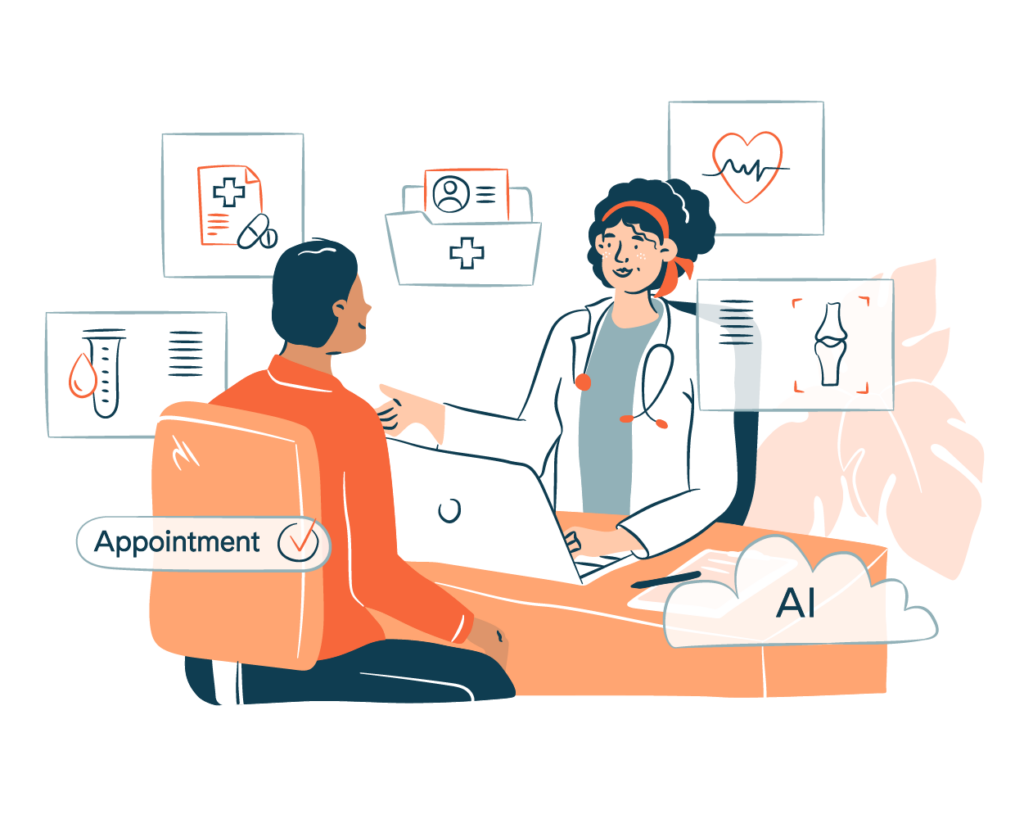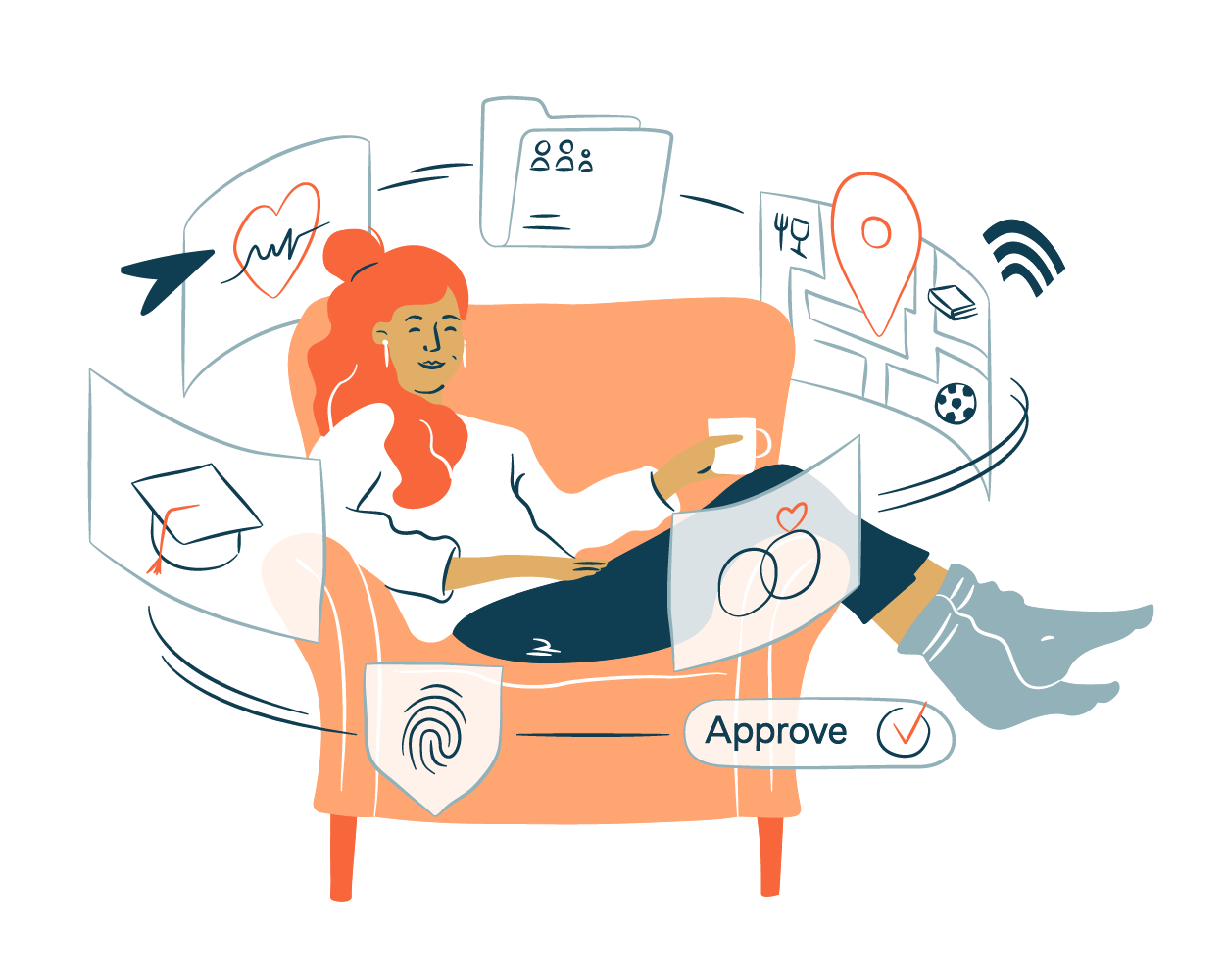Automation and artificial intelligence could simplify daily lives and increase our wellbeing. We are already using digitalisation for things that don’t really matter, but what if we used it for truly important things?
Expect to learn
- What does human-centric approach to designing digital services mean and why it’s crucial
- What are the key steps to a fully automated digital society that can work as a wellbeing-generating ecosystem
- How AI and ethical design of digital services can support people in difficult life events
Family Larsson is about to start an exciting new phase in life as they get ready for a move to a new city. Mother Anna grabs her phone and logs into her digital assistant, or Susie as Anna likes to call her, using a secure e-identification to quickly type in the details about the forthcoming change. Susie prepares a notification right away to all necessary authorities including the postal service, electric, insurance and banking companies, and phone and internet providers.
Susie also drafts a list of schools and kindergartens in the area and gets the application forms ready for the children Max, 14, Alex, 10, and Alice, 8. It automatically redirects the family’s food subscription boxes to the new address, and provides information about local services including the public and private healthcare, libraries, and sports facilities for the whole family.
Susie knows that Max and Alice play football and it recommends suitable teams nearby their new home. She also suggests restaurants and coffee shops to match the family’s taste and budget, and lists the best hiking routes, beaches, and playgrounds in the area. All the family needs to do is to accept the suggestions and pack their belongings.
The hassle-free life of the Larsson family is a utopia but it could just as well be the new reality. We already have an infrastructure for it, says Riikka Vilminko-Heikkinen, Director of Sales and Customer Value at Gofore, and a self-confessed idealist.
What is needed is a human-centric approach: Instead of designing digital services from the service provider’s perspective, they are created and tailored to meet individual needs and preferences. Built around this principle, a digital society resembles a wellbeing-generating ecosystem that can identify and support life events from birth to death, and everything in between.
”We are already using digitalisation for things that don’t really matter, including smart home appliances—what if we used it for truly important things like dealing with bureaucratic processes or reducing the administrative burden in healthcare? The transformation won’t happen overnight but we shouldn’t let perfect be the enemy of good. It is important to go in the right direction,” Vilminko-Heikkinen says.
We are already using digitalisation for things that don’t really matter, but what if we used it to automate the really important things?
Technology supports when life happens
In today’s reality, the Larsson family would most likely spend days filling in paper forms, making phone calls, and preparing long lists of things they must remember to do.
Even if many of the service interfaces have been digitalized, most of the services are still operated by humans. When the family applies for a housing benefit, they do so online but it still takes around 21 days for the decision to come through.
Digital processes that rely on human power can be slow, expensive, and ineffective, says Gofore’s Lead AI consultant Pasi Lehtimäki, who has over 20 years of experience in analytics and software development.
“AI could make the decision in two seconds. This would save time, money and effort, and improve the quality of the services. The people in the most vulnerable position—those who use social services and need assistance frequently—could benefit the most if the decision-making process was made faster by automation,” he says.
In a human-centric digital society the application process is not only speedier but the whole system is taken to the next level. Instead of us having to spend time looking for the right application form for early childhood education, make annual doctor’s appointments, or find out which services we are entitled to, these services come to us. This is made possible by automation and AI – our digital assistant is always up to date with our life situation and can therefore suggest appropriate services proactively.
Birth, marriage, and divorce are major life changes that can cause emotional imbalance. On top of adjusting to a new situation we need to deal with authorities and service providers.
“A death of a loved one can be emotionally very taxing – and a bureaucratic nightmare.
It is absurd because it doesn’t have to be that way,” says Vilminko-Heikkinen who thinks that the services must be designed so that they take difficult life events into account and nudge people forward in a caring, sympathetic way.
“The death of a loved one can be a bureaucratic nightmare. It doesn’t have to be that way.”
The transformation from the current system to a fully automated one is not as complicated as one might think. Many countries have government-run digital platforms already, such as Suomi.fi in Finland and Borger.dk in Denmark, which could be used as a basis. The digital assistant, or what Anna Larsson calls Susie, could easily move data across government agencies but also private organisations and service providers.
“This way the digital assistant would always be up to date with our family situation, health and work status, living arrangements and personal preferences—to the extent that we allow it to be. By analysing the available data, it can predict and identify life events we are about to enter, and suggest tailored services to meet our needs”, says Head of Business in the Cities segment, Simo Turunen, who has been creating digital solutions and services to the public sector and cities at Gofore for the past four years.

Automation is not an option – it’s a must
Sorting out our everyday tasks is one thing but there are a lot bigger global problems that will define how we live, work, and play in the future. By 2050, two thirds of the global population will live in cities. Combined with the ageing of the population and the growing lack of workforce we need solutions and we need them fast. Automating tasks that can be automated is not just an option—it is a necessity.
Healthcare is a prime example of a sector, where automation and AI could benefit all parties without sacrificing quality. Private service providers as well as the public healthcare system could operate in a more cost-effective and efficient way if tasks such as prescription renewals and basic health assessments and diagnostics were automated. By analysing available health data, AI could suggest appropriate treatment—and a consultation with a doctor when needed—with a focus in preventative care. This could improve the patient’s quality of life too. Even better, technology can help with the staff shortage by saving the valuable time of doctors and other healthcare professionals.
The global COVID-19 crisis accelerated the digital transformation but some people are still frightened of the change. Many fear that AI will replace people while others worry that the quality of the services will suffer when they are digitalized.
“There is no need for that fear,” argues Pasi Lehtimäki. “We are currently going through a transition phase where manual services are replaced with digital ones, and we haven’t been able to fully see the benefits yet.”
“Developing inclusive applications and systems won’t happen overnight but we have to start somewhere. There is so much we can do.”
“Some people would rather maintain the current situation than see the change happen but we should acknowledge that the present system is not equal. Some people are left out and we should make sure that we don’t let down those people in the future as well. Developing inclusive applications and systems won’t happen overnight but we have to start somewhere. There is so much we can do,” he says.
When AI is used for tasks it is most suitable dealing with, humans are freed up to do what they do best: listen, support, and be physically present for those who need it.
”When AI is used for tasks it is most suitable dealing with, humans are freed up to do what they do best: listen, support, and be physically present for those who need it.”
Safety first
If AI sounds like a flawless solution to all our problems, it’s good to remember that very few things are. One of the main challenges with building a digital society is that the amount of personal data increases. This creates opportunities for vulnerabilities such as misuse and cyber threats.
“Data-driven services place the consumer in a weaker position than ever. All institutions and authorities should put consumers, citizens, and democracies at the front and centre in the AI age,” says Ursula Pachl, the Deputy Director General at BEUC, The European Consumer Organisation; and the co-author of A Human-Centric Digital Manifesto for Europe.
As a response, the EU, for example, has taken great strides in AI-related legislation – GDPR, AI Act, Digital Markets Act (DMA) and Digital Services Act (DSA) to name a few – strengthening the digital security of citizens.
According to Pasi Lehtimäki, also the service providers and designers are paying more attention to ethics and data protection.
”Ethics and safeguarding data protection have become an intrinsic part of designing digital solutions. Again, the key is human-centricity and the ability to understand individual differences – and here AI is better than the conventional systems,” Lehtimäki says.
As a pioneer, Gofore launched a booklet on ethical design in 2022.
“All institutions and authorities should put consumers, citizens, and democracies at the front and centre in the AI age.”
People at the core – and in the driver’s seat
To ensure that we use technology for our benefit—and not the other way around—it is crucial to ask ourselves what our values and goals are, and how technology can help us achieve these. It also means reassessing how success is measured.
Profitability and revenue are typically top indicators of success but when it comes to humans and their wellbeing, this approach doesn’t quite cut it, Pasi Lehtimäki says.
“We need a paradigm shift. Instead of measuring how many appointments a doctor has in one day, or how much money is generated, we should also measure how well the doctor is able to help their patients. It is one of my key findings in years of working that we cannot do this without the data acquired and analysed by technology,” says Lehtimäki.
”Instead of measuring the quantity of appointments, or how much money is generated, we should also measure how well the doctor is able to help their patients. We cannot do this without technology.”
One of the top benefits of using AI and automation is that we are rewarded with more free time—yet it’s valuable only if we use it wisely. The chronic stress that affects more and more workers all over the world proves that us humans are very good at filling any spare time with more tasks.
“To me, protected and even paid time for rest—and with it, joy, leisure, games, reprieve, sleep—is a necessary counterbalance to technological innovations in AI,” says Jonnie Penn, artificial intelligence researcher and an Assistant Teaching Professor of AI Ethics and Society at the University of Cambridge.
Relying on AI alone can, as Penn says, turn the world into a big laboratory or a factory if we fail to notice that many of our current problems are created by humans, not technology, and thus need to be solved by us. This idea is also present in Gofore’s take on ethical design: ethical digitalisation should recognise the need for social innovations as much as technological ones.
At the end of the day, technology can and should do its part but us humans need to take the lead.
“The first industrial revolution helped to naturalise the weekend. What comes next?” Penn concludes.
